LiDAR-Assisted UAV Variable-Rate Spraying System
Abstract
1. Introduction
2. Materials and Methods
2.1. Experimental Site
2.2. Point Cloud and Visible-Light Data Acquisition
2.3. Data Preprocessing
2.3.1. Point Cloud Data Preprocessing
2.3.2. Visible-Light Data Preprocessing
2.4. Data Processing
2.4.1. LiDAR Feature Variable Extraction
2.4.2. Canopy Cover Extraction
2.4.3. Visible-Light Vegetation Index Extraction
2.5. Model Evaluation and Results Analysis
2.5.1. Model Performance Assessment
2.5.2. Comparative Analysis
2.5.3. Variable-Rate Spraying Prescription Map Generation
3. Variable-Rate Spraying System Design
3.1. Hardware Components
3.2. Variable-Rate Spray Control Model
3.3. Software Design
3.4. Field Experiment
4. Results
4.1. Spray Deposition
4.2. Spray Coverage
5. Discussion
6. Conclusions
Author Contributions
Funding
Institutional Review Board Statement
Data Availability Statement
Conflicts of Interest
References
- Voss-Fels, K.P.; Stahl, A.; Wittkop, B.; Lichthardt, C.; Nagler, S.; Rose, T.; Chen, T.-W.; Zetzsche, H.; Seddig, S.; Majid Baig, M.; et al. Breeding Improves Wheat Productivity under Contrasting Agrochemical Input Levels. Nat. Plants 2019, 5, 706–714. [Google Scholar] [CrossRef]
- Cheng, S.; Feng, C.; Wingen, L.U.; Cheng, H.; Riche, A.B.; Jiang, M.; Leverington-Waite, M.; Huang, Z.; Collier, S.; Orford, S.; et al. Harnessing Landrace Diversity Empowers Wheat Breeding. Nature 2024, 632, 823–831. [Google Scholar] [CrossRef]
- Deery, D.M.; Rebetzke, G.J.; Jimenez-Berni, J.A.; James, R.A.; Condon, A.G.; Bovill, W.D.; Hutchinson, P.; Scarrow, J.; Davy, R.; Furbank, R.T. Methodology for High-Throughput Field Phenotyping of Canopy Temperature Using Airborne Thermography. Front. Plant Sci. 2016, 7, 1808. [Google Scholar] [CrossRef] [PubMed]
- Jiao, C.; Xie, X.; Hao, C.; Chen, L.; Xie, Y.; Garg, V.; Zhao, L.; Wang, Z.; Zhang, Y.; Li, T.; et al. Pan-Genome Bridges Wheat Structural Variations with Habitat and Breeding. Nature 2025, 637, 384–393. [Google Scholar] [CrossRef] [PubMed]
- Aranguren, M.; Castellón, A.; Aizpurua, A. Crop Sensor Based Non-Destructive Estimation of Nitrogen Nutritional Status, Yield, and Grain Protein Content in Wheat. Agriculture 2020, 10, 148. [Google Scholar] [CrossRef]
- Wan, N.-F.; Fu, L.; Dainese, M.; Kiær, L.P.; Hu, Y.-Q.; Xin, F.; Goulson, D.; Woodcock, B.A.; Vanbergen, A.J.; Spurgeon, D.J.; et al. Pesticides Have Negative Effects on Non-Target Organisms. Nat. Commun. 2025, 16, 1360. [Google Scholar] [CrossRef]
- Xiongkui, H. Research progress and developmental recommendations on precision spraying technology and equipment in China. Smart Agric. 2020, 2, 133–146. [Google Scholar]
- Gatkal, N.R.; Sachin, M.N.; Girishkumar, B.B.; Ramesh, K.S.; Avdhoot, A.W.; Pravin, B.K.; Ali, M. Review of UAVs for Efficient Agrochemical Spray Application. Int. J. Agric. Biol. Eng. 2025, 18, 1–9. [Google Scholar]
- Barcelos, C.O.; Fagundes-Júnior, L.A.; Mendes, A.L.C.; Gandolfo, D.C.; Brandão, A.S. Integration of Payload Sensors to Enhance UAV-Based Spraying. Drones 2024, 8, 490. [Google Scholar] [CrossRef]
- Chen, P.; Ouyang, F.; Wang, G.; Qi, H.; Xu, W.; Yang, W.; Zhang, Y.; Lan, Y. Droplet Distributions in Cotton Harvest Aid Applications Vary with the Interactions among the Unmanned Aerial Vehicle Spraying Parameters. Ind. Crops Prod. 2021, 163, 113324. [Google Scholar] [CrossRef]
- Chen, P.; Xu, W.; Zhan, Y.; Wang, G.; Yang, W.; Lan, Y. Determining Application Volume of Unmanned Aerial Spraying Systems for Cotton Defoliation Using Remote Sensing Images. Comput. Electron. Agric. 2022, 196, 106912. [Google Scholar] [CrossRef]
- Liu, J.; Zhao, C.; Yang, G.; Yu, H.; Zhao, X.; Xu, B.; Niu, Q. Review of field-based phenotyping by unmanned aerial vehicle remote sensing platform. Trans. Chin. Soc. Agric. Eng. (Trans. CSAE) 2016, 32, 98–106. [Google Scholar]
- Zhang, D.; Qi, H.; Guo, X.; Sun, H.; Min, J.; Li, S.; Hou, L.; Lv, L. Integration of UAV Multispectral Remote Sensing and Random Forest for Full-Growth Stage Monitoring of Wheat Dynamics. Agriculture 2025, 15, 353. [Google Scholar] [CrossRef]
- Fu, W.; Chen, Z.; Cheng, Q.; Li, Y.; Zhai, W.; Ding, F.; Kuang, X.; Chen, D.; Duan, F. Maize Leaf Area Index Estimation Based on Machine Learning Algorithm and Computer Vision. Agriculture 2025, 15, 1272. [Google Scholar] [CrossRef]
- Fu, Y.; Yang, G.; Wang, J.; Song, X.; Feng, H. Winter Wheat Biomass Estimation Based on Spectral Indices, Band Depth Analysis and Partial Least Squares Regression Using Hyperspectral Measurements. Comput. Electron. Agric. 2014, 100, 51–59. [Google Scholar] [CrossRef]
- Golzarian, M.R.; Frick, R.A. Classification of Images of Wheat, Ryegrass and Brome Grass Species at Early Growth Stages Using Principal Component Analysis. Plant Methods 2011, 7, 28. [Google Scholar] [CrossRef]
- Hunt, E.R.; Cavigelli, M.; Daughtry, C.S.T.; Mcmurtrey, J.E.; Walthall, C.L. Evaluation of Digital Photography from Model Aircraft for Remote Sensing of Crop Biomass and Nitrogen Status. Precis. Agric 2005, 6, 359–378. [Google Scholar] [CrossRef]
- Liebisch, F.; Kirchgessner, N.; Schneider, D.; Walter, A.; Hund, A. Remote, Aerial Phenotyping of Maize Traits with a Mobile Multi-Sensor Approach. Plant Methods 2015, 11, 9. [Google Scholar] [CrossRef]
- Jiang, Q.; Fang, S.; Peng, Y.; Gong, Y.; Zhu, R.; Wu, X.; Ma, Y.; Duan, B.; Liu, J. UAV-Based Biomass Estimation for Rice-Combining Spectral, TIN-Based Structural and Meteorological Features. Remote Sens. 2019, 11, 890. [Google Scholar] [CrossRef]
- Shao, G.; Wang, Y.; Han, W. Estimation Method of Leaf Area Index for Summer Maize Using UAV-Based Multispectral Remote Sensing. Smart Agric. 2020, 2, 118. [Google Scholar]
- Lacerda, L.N.; Ardigueri, M.C.; Barboza, T.O.; Snider, J.; Chalise, D.P.; Gobbo, S.; Vellidis, G. Using High-Resolution Multispectral Data to Evaluate In-Season Cotton Growth Parameters and End-of-the-Season Cotton Fiber Yield and Quality. Agronomy 2025, 15, 692. [Google Scholar] [CrossRef]
- Zheng, H.; Cheng, T.; Zhou, M.; Li, D.; Yao, X.; Tian, Y.; Cao, W.; Zhu, Y. Improved Estimation of Rice Aboveground Biomass Combining Textural and Spectral Analysis of UAV Imagery. Precis. Agric 2019, 20, 611–629. [Google Scholar] [CrossRef]
- Li, Z.; Feng, X.; Li, J.; Wang, D.; Hong, W.; Qin, J.; Wang, A.; Ma, H.; Yao, Q.; Chen, S. Time Series Field Estimation of Rice Canopy Height Using an Unmanned Aerial Vehicle-Based RGB/Multispectral Platform. Agronomy 2024, 14, 883. [Google Scholar] [CrossRef]
- Yue, J.; Yang, G.; Tian, Q.; Feng, H.; Xu, K.; Zhou, C. Estimate of Winter-Wheat above-Ground Biomass Based on UAV Ultrahigh-Ground-Resolution Image Textures and Vegetation Indices. ISPRS J. Photogramm. Remote Sens. 2019, 150, 226–244. [Google Scholar] [CrossRef]
- Hütt, C.; Bolten, A.; Hüging, H.; Bareth, G. UAV LiDAR Metrics for Monitoring Crop Height, Biomass and Nitrogen Uptake: A Case Study on a Winter Wheat Field Trial. PFG 2023, 91, 65–76. [Google Scholar] [CrossRef]
- Ten Harkel, J.; Bartholomeus, H.; Kooistra, L. Biomass and Crop Height Estimation of Different Crops Using UAV-Based Lidar. Remote Sens. 2019, 12, 17. [Google Scholar] [CrossRef]
- Wang, L.; Zhang, R.; Zhang, L.; Yi, T.; Zhang, D.; Zhu, A. Research on Individual Tree Canopy Segmentation of Camellia Oleifera Based on a UAV-LiDAR System. Agriculture 2024, 14, 364. [Google Scholar] [CrossRef]
- Bouvier, M.; Durrieu, S.; Fournier, R.A.; Renaud, J.-P. Generalizing Predictive Models of Forest Inventory Attributes Using an Area-Based Approach with Airborne LiDAR Data. Remote Sens. Environ. 2015, 156, 322–334. [Google Scholar] [CrossRef]
- Lim, K.; Treitz, P.; Wulder, M.; St-Onge, B.; Flood, M. LiDAR Remote Sensing of Forest Structure. Prog. Phys. Geogr. Earth Environ. 2003, 27, 88–106. [Google Scholar] [CrossRef]
- Stovall, A.E.L.; Vorster, A.G.; Anderson, R.S.; Evangelista, P.H.; Shugart, H.H. Non-Destructive Aboveground Biomass Estimation of Coniferous Trees Using Terrestrial LiDAR. Remote Sens. Environ. 2017, 200, 31–42. [Google Scholar] [CrossRef]
- Greaves, H.E.; Vierling, L.A.; Eitel, J.U.H.; Boelman, N.T.; Magney, T.S.; Prager, C.M.; Griffin, K.L. Estimating Aboveground Biomass and Leaf Area of Low-Stature Arctic Shrubs with Terrestrial LiDAR. Remote Sens. Environ. 2015, 164, 26–35. [Google Scholar] [CrossRef]
- Zhu, Y.; Sun, G.; Ding, G.; Zhou, J.; Wen, M.; Jin, S.; Zhao, Q.; Colmer, J.; Ding, Y.; Ober, E.S.; et al. Large-Scale Field Phenotyping Using Backpack LiDAR and CropQuant-3D to Measure Structural Variation in Wheat. Plant Physiol. 2021, 187, 716–738. [Google Scholar] [CrossRef]
- Fareed, N.; Das, A.K.; Flores, J.P.; Mathew, J.J.; Mukaila, T.; Numata, I.; Janjua, U.U.R. UAS Quality Control and Crop Three-Dimensional Characterization Framework Using Multi-Temporal LiDAR Data. Remote Sens. 2024, 16, 699. [Google Scholar] [CrossRef]
- Sofonia, J.; Shendryk, Y.; Phinn, S.; Roelfsema, C.; Kendoul, F.; Skocaj, D. Monitoring Sugarcane Growth Response to Varying Nitrogen Application Rates: A Comparison of UAV SLAM LiDAR and Photogrammetry. Int. J. Appl. Earth Obs. Geoinf. 2019, 82, 101878. [Google Scholar] [CrossRef]
- Chen, P.; Ma, H.; Cui, Z.; Li, Z.; Wu, J.; Liao, J.; Liu, H.; Wang, Y.; Lan, Y. Field Study of UAV Variable-Rate Spraying Method for Orchards Based on Canopy Volume. Agriculture 2025, 15, 1374. [Google Scholar] [CrossRef]
- Luo, S.; Wen, S.; Zhang, L.; Lan, Y.; Chen, X. Extraction of Crop Canopy Features and Decision-Making for Variable Spraying Based on Unmanned Aerial Vehicle LiDAR Data. Comput. Electron. Agric. 2024, 224, 109197. [Google Scholar] [CrossRef]
- Tao, H.; Xu, L.; Feng, H.; Yang, G.; Yang, X.; Miao, M.; Dai, Y. Estimation of plant height and biomass of winter wheat based on UAV digital image. Trans. Chin. Soc. Agric. Eng. (Trans. CSAE) 2019, 35, 107–116. [Google Scholar]
- Zhu, H.; Salyani, M.; Fox, R.D. A portable scanning system for evaluation of spray deposit distribution. Comput. Electron. Agric. 2011, 76, 38–43. [Google Scholar] [CrossRef]
- Li, X.; Liang, Z.; Yang, G.; Lin, T.; Liu, B. Assessing the Severity of Verticillium Wilt in Cotton Fields and Constructing Pesticide Application Prescription Maps Using Unmanned Aerial Vehicle (UAV) Multispectral Images. Drones 2024, 8, 176. [Google Scholar] [CrossRef]
- Zhang, L.; Sun, B.; Zhao, D.; Shan, C.; Wang, G.; Song, C.; Chen, P.; Lan, Y. Prediction of Cotton FPAR and Construction of Defoliation Spraying Prescription Map Based on Multi-Source UAV Images. Comput. Electron. Agric. 2024, 220, 108897. [Google Scholar] [CrossRef]
- Chen, P.; Xu, W.; Zhan, Y.; Yang, W.; Wang, J.; Lan, Y. Evaluation of Cotton Defoliation Rate and Establishment of Spray Prescription Map Using Remote Sensing Imagery. Remote Sens. 2022, 14, 4206. [Google Scholar] [CrossRef]
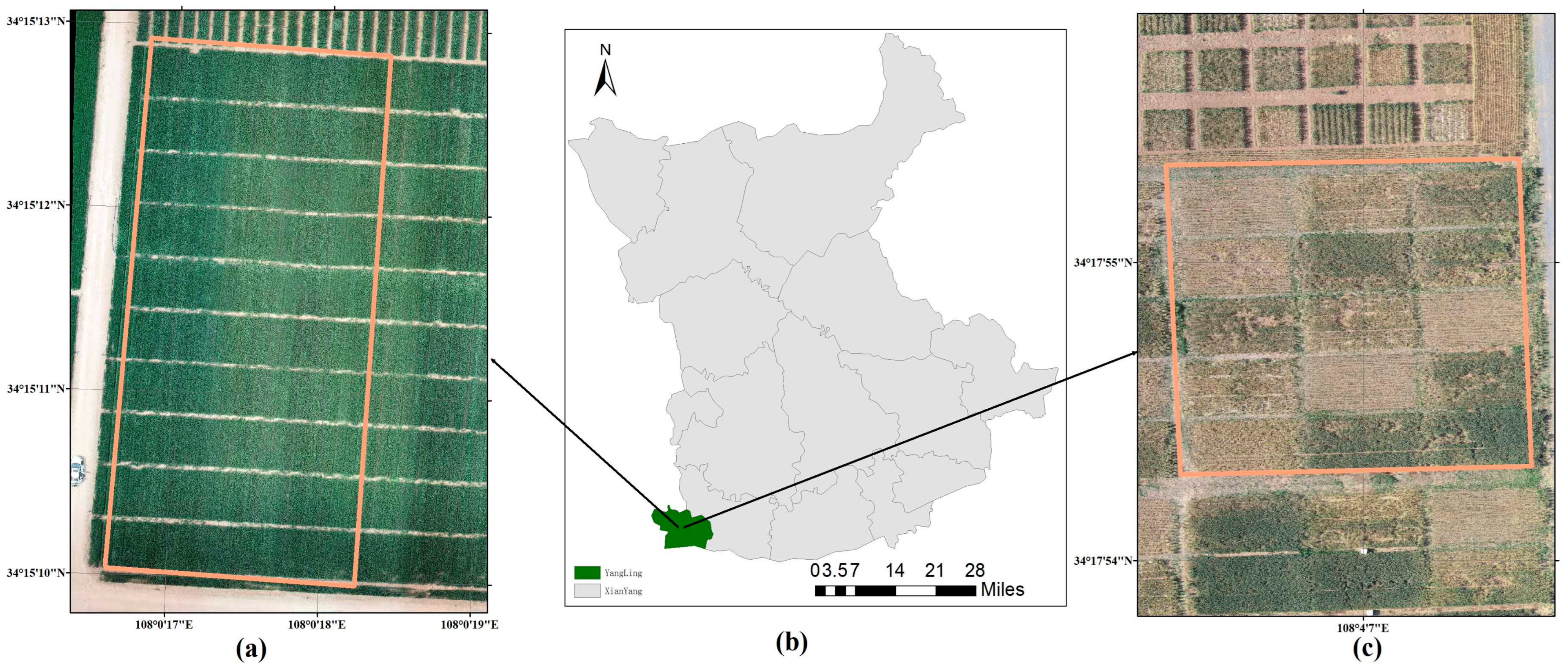





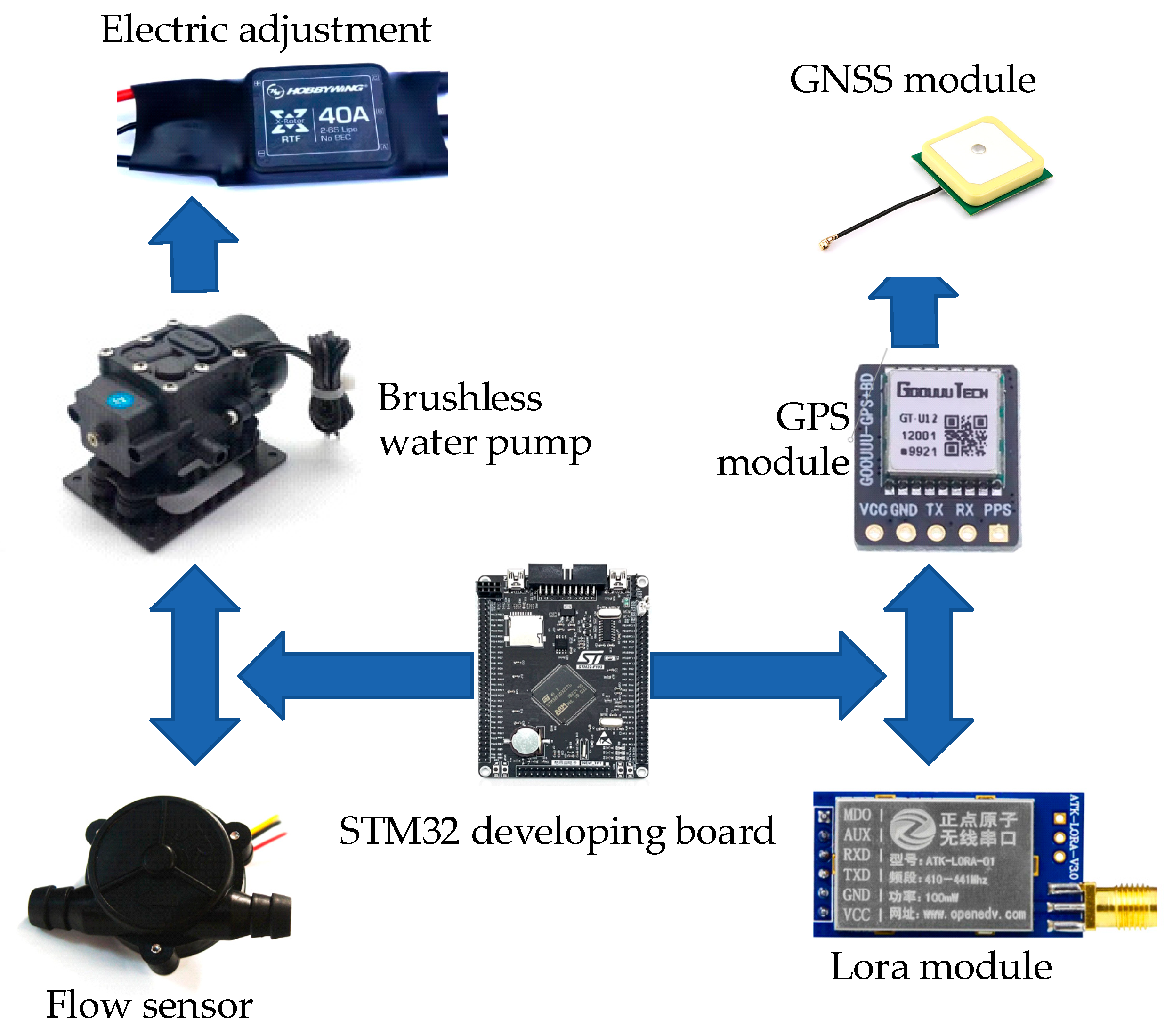



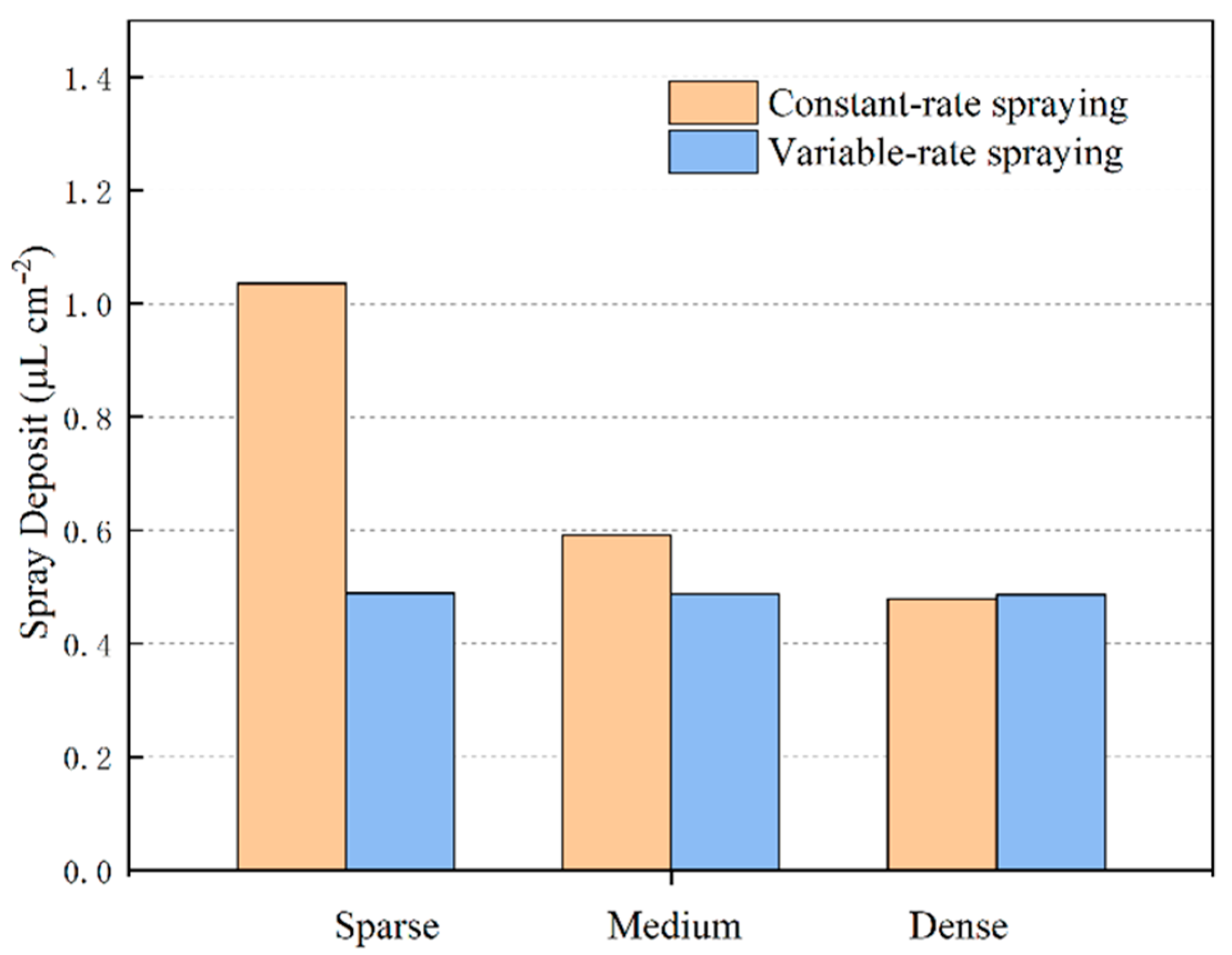
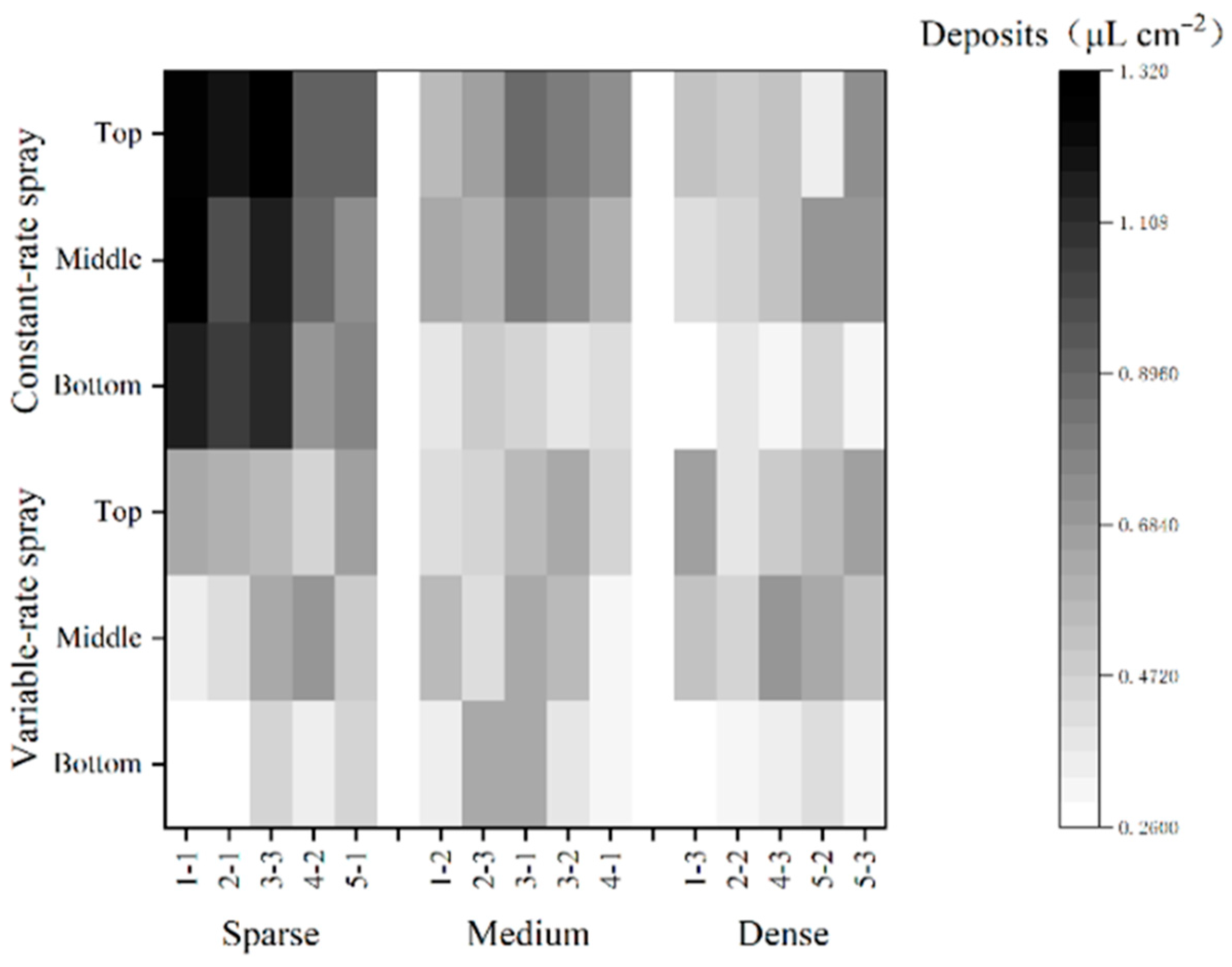
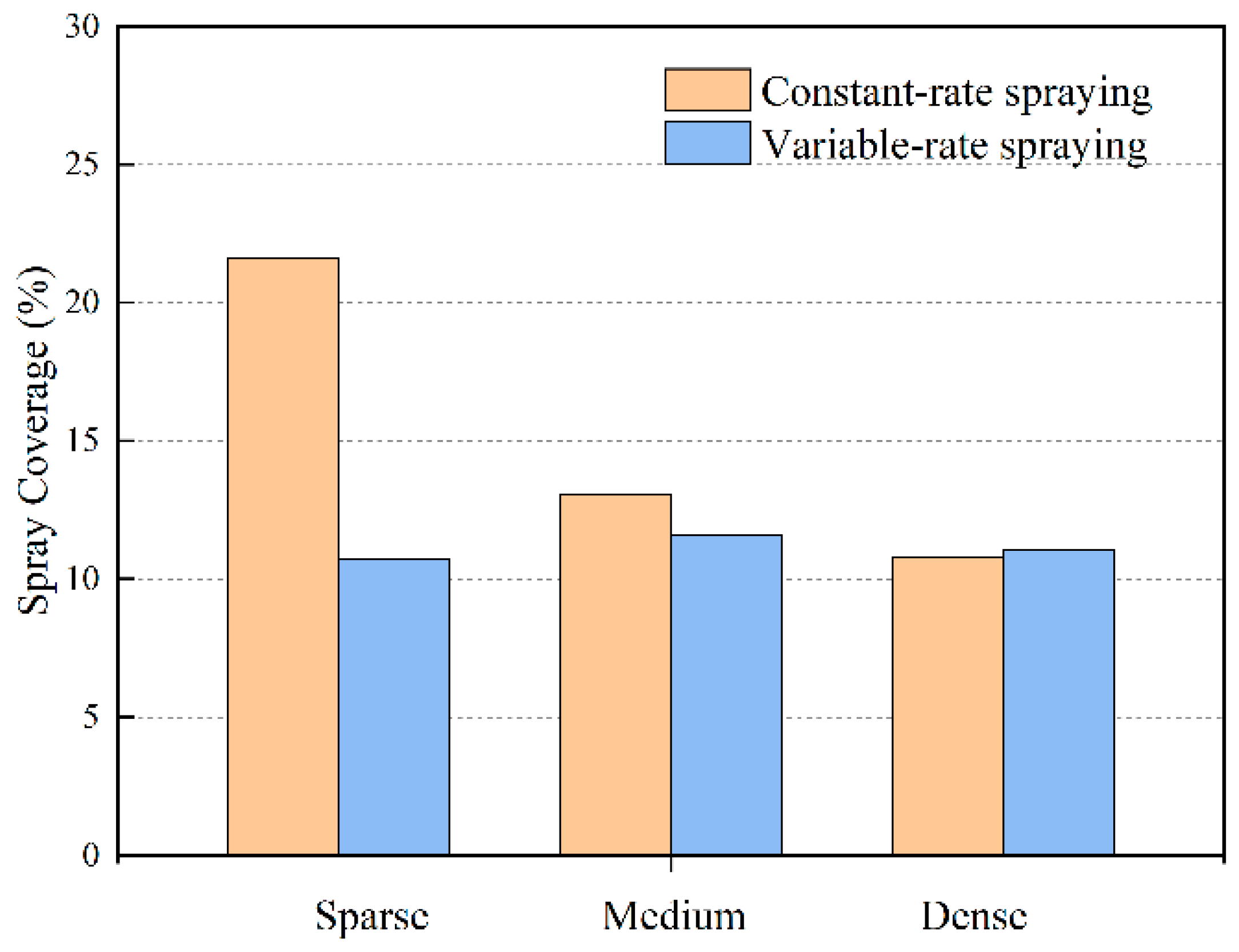

| Variable | Description |
|---|---|
| Hmean | Mean height |
| Hmax | Maximum height |
| Hsd | Height standard deviation |
| Hvar | Height variance |
| Hcv | Coefficient of variation |
| Hmad | Median absolute deviation |
| Hskew | Height skewness |
| H(40th,50th,60th,70th,80th,90th,95th,99th) | Percentile heights |
| CPR | Canopy relief ratio |
| Visible-Light Vegetation Index | Formula | Visible-Light Vegetation Index | Formula |
|---|---|---|---|
| r | R/R + G + B | r/b | r/b |
| g | R/R + G + B | g/b | g/b |
| r − b | R − b | g − b | g − b |
| r + b | R + b | (r − b)/(r + b) | (r − b)/(r + b) |
| (r − g − b)/(r + g) | (r − g − b)/(r + g) | GRVI | (g − r)/(g + r) |
| EXG | 2g − b − r | MGRVI | (g2 − r2)/(g2 + r2) |
| RGBVI | (g2 − br)/(g2 + br) | NDI | (r − g)/(r + g + 0.01) |
| EXR | 1.4r − g | VARI | (g − r)/(g + r − b) |
| EXGR | 3g − 2.4r − b | GLA | (2G − B − R)/(2G + B + R) |
| CIVE | 0.441r − 0.881g + 0.385b + 18.78745 |
| Model | Features | R2 | RMSE (g/m2) |
|---|---|---|---|
| SR | Visible-Light Vegetation Indices | 0.618 | 305.456 |
| Visible-Light Vegetation Indices, Canopy Cover and LiDAR Feature Variables | 0.709 | 256.544 | |
| PLSR | Visible-Light Vegetation Indices | 0.626 | 274.319 |
| Visible-Light Vegetation Indices, Canopy Cover and LiDAR Feature Variables | 0.730 | 246.351 | |
| RF | Visible-Light Vegetation Indices | 0.823 | 210.857 |
| Visible-Light Vegetation Indices, Canopy Cover and LiDAR Feature Variables | 0.834 | 202.431 |
| Zone | CRA | VRA |
|---|---|---|
| Sparse | 1.035 | 0.489 |
| Moderate | 0.608 | 0.488 |
| Dense | 0.480 | 0.486 |
| Zone | CRA | VRA |
|---|---|---|
| Sparse | 21.60 | 10.72 |
| Moderate | 13.09 | 11.57 |
| Dense | 10.80 | 11.05 |
Disclaimer/Publisher’s Note: The statements, opinions and data contained in all publications are solely those of the individual author(s) and contributor(s) and not of MDPI and/or the editor(s). MDPI and/or the editor(s) disclaim responsibility for any injury to people or property resulting from any ideas, methods, instructions or products referred to in the content. |
© 2025 by the authors. Licensee MDPI, Basel, Switzerland. This article is an open access article distributed under the terms and conditions of the Creative Commons Attribution (CC BY) license (https://creativecommons.org/licenses/by/4.0/).
Share and Cite
Liu, X.; Liu, Y.; Chen, X.; Wan, Y.; Gao, D.; Cao, P. LiDAR-Assisted UAV Variable-Rate Spraying System. Agriculture 2025, 15, 1782. https://doi.org/10.3390/agriculture15161782
Liu X, Liu Y, Chen X, Wan Y, Gao D, Cao P. LiDAR-Assisted UAV Variable-Rate Spraying System. Agriculture. 2025; 15(16):1782. https://doi.org/10.3390/agriculture15161782
Chicago/Turabian StyleLiu, Xuhang, Yicheng Liu, Xinhanyang Chen, Yuhan Wan, Dengxi Gao, and Pei Cao. 2025. "LiDAR-Assisted UAV Variable-Rate Spraying System" Agriculture 15, no. 16: 1782. https://doi.org/10.3390/agriculture15161782
APA StyleLiu, X., Liu, Y., Chen, X., Wan, Y., Gao, D., & Cao, P. (2025). LiDAR-Assisted UAV Variable-Rate Spraying System. Agriculture, 15(16), 1782. https://doi.org/10.3390/agriculture15161782







